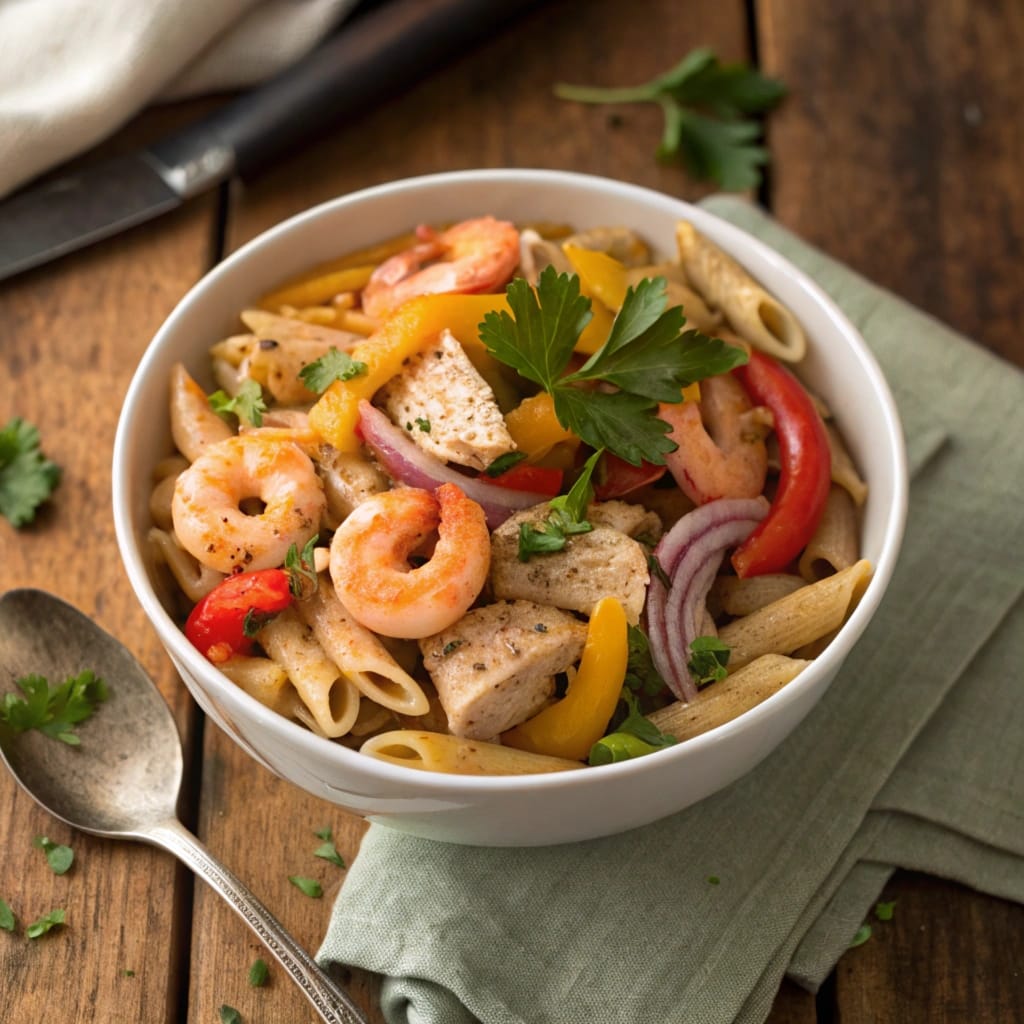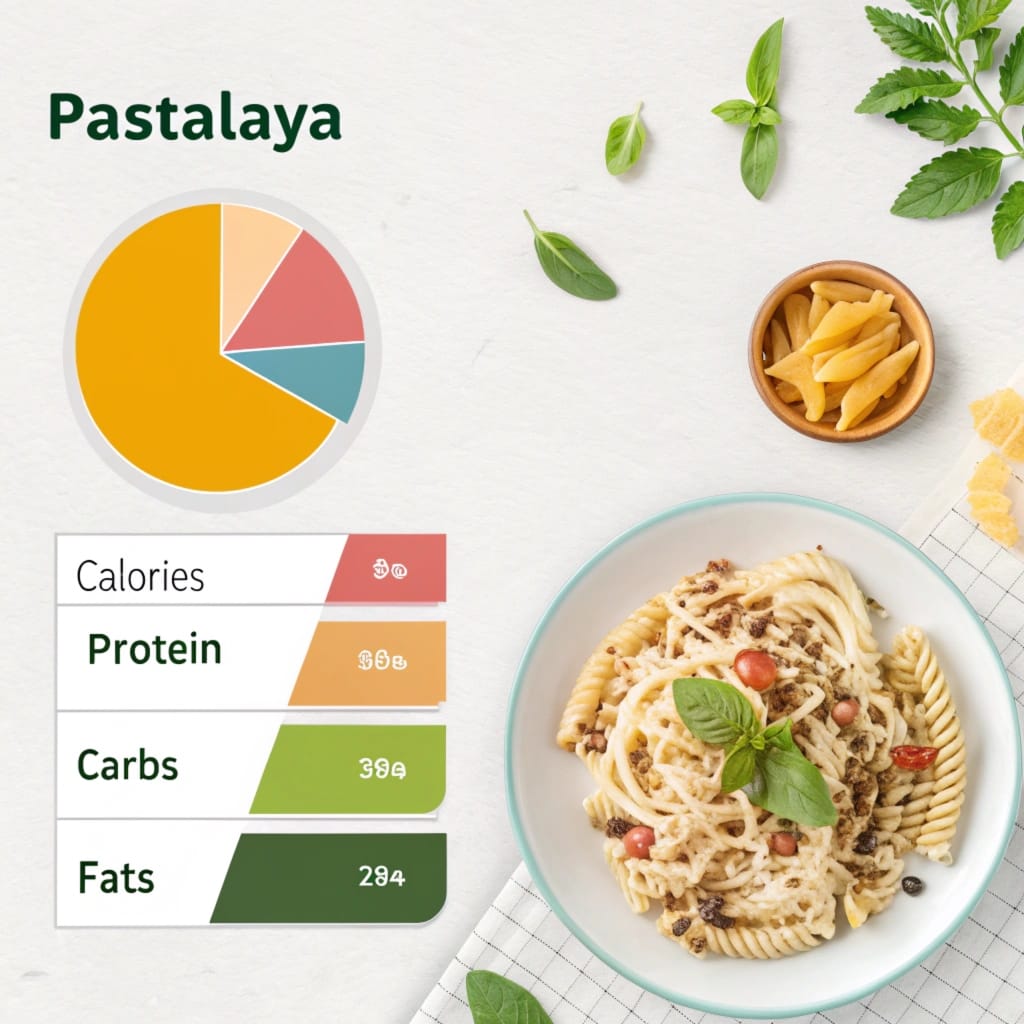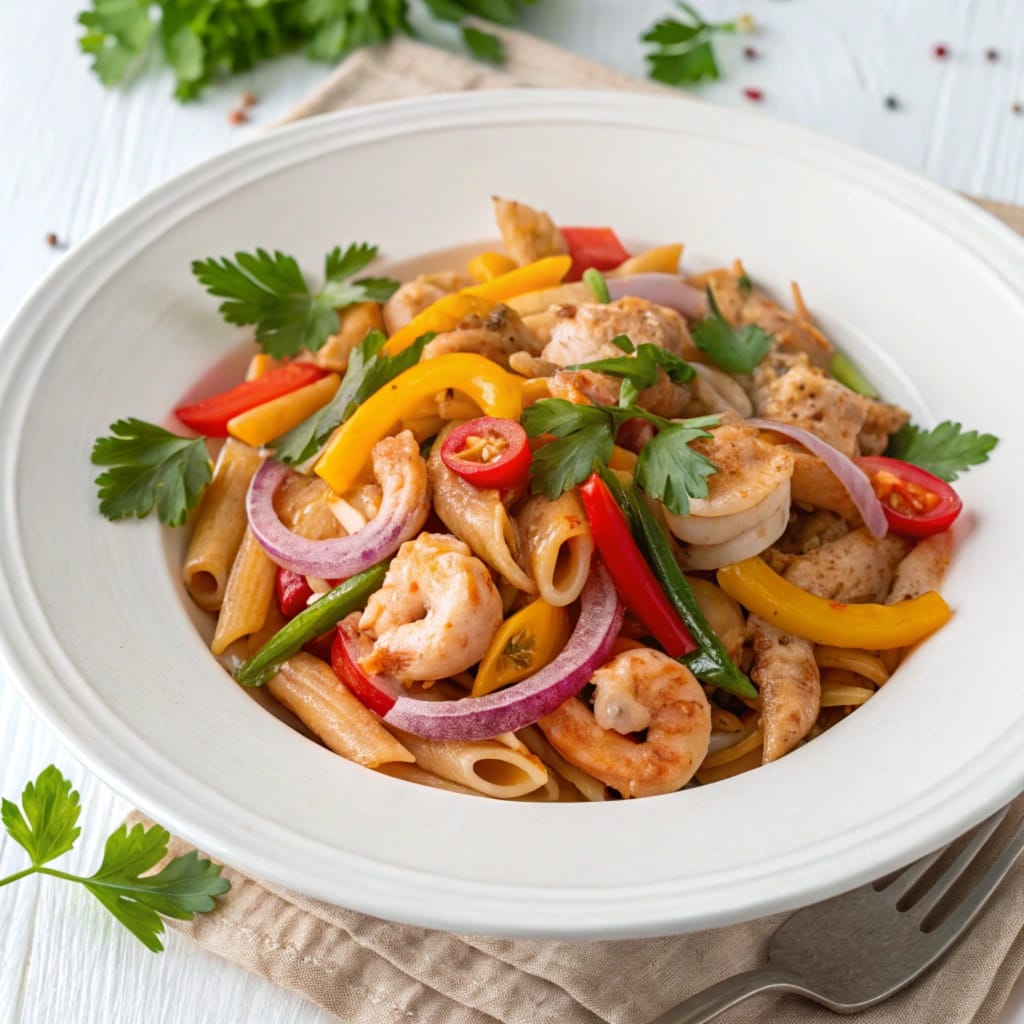Is Pastalaya Healthy?Pastalaya is a Louisiana-inspired dish that masterfully combines the bold flavors of traditional jambalaya with pasta instead of rice. Typically, it features pasta, smoked sausage, chicken, shrimp, vegetables, and a mix of Cajun spices. This hearty meal is loved for its rich taste and filling nature, making it a go-to dish for family gatherings, potlucks, and parties.
However, when it comes to health, people often wonder: Is pastalaya a healthy meal choice? At first glance, it may seem balanced since it contains a mix of protein, carbs, and vegetables. Nevertheless, the health impact of pastalaya depends significantly on how it’s made. For instance, some recipes use processed meats, refined pasta, and high-sodium seasonings, which may not align with a health-focused lifestyle. On the other hand, healthier versions use whole-grain pasta, lean proteins, and fresh vegetables, making it a more nutritious option.
In this article, we’ll explore pastalaya from a health perspective. Specifically, we’ll analyze its nutritional profile, discuss its health benefits and drawbacks, and provide practical tips on how to make a healthier version at home. By the end, you’ll have a clear understanding of whether pastalaya is a smart option for your diet.

Table of contents
Nutritional Profile of Pastalaya Healthy
To determine if pastalaya is healthy, it’s essential to analyze its nutritional content. The exact nutritional values of pastalaya can vary depending on the ingredients and portion sizes. However, we can break down its components to understand the calorie count, macronutrients (carbohydrates, protein, fats), vitamins, and minerals.
Calories in Pastalaya
The calorie content of pastalaya depends on the type and quantity of pasta, protein, vegetables, and seasonings used. On average, a 1-cup serving of traditional pastalaya contains approximately:
- Calories: 350 – 450 kcal
- Protein: 18 – 25 g
- Carbohydrates: 40 – 50 g
- Fats: 10 – 15 g
- Fiber: 2 – 5 g
- Sodium: 800 – 1,200 mg (can vary significantly depending on seasonings)
These numbers can fluctuate based on the use of whole-grain pasta versus refined pasta, lean protein versus processed sausage, and the quantity of oil, butter, or high-sodium spices used in the cooking process.
Macronutrients in Pastalaya
Carbohydrates in Pastalaya
The main source of carbohydrates in pastalaya comes from pasta. If white pasta is used, the dish becomes a significant source of refined carbs, which are quickly digested and can cause blood sugar spikes. Alternatively, if whole-grain or chickpea pasta is used, you’ll get more fiber, which promotes better blood sugar control and keeps you fuller for longer.
Key Takeaway:
- Refined Pasta = High glycemic index, less fiber, and shorter satiety.
- Whole-Grain or Legume Pasta = Low glycemic index, higher fiber, and longer satiety.
Protein in Pastalaya Healthy
Protein is a highlight of pastalaya, especially if it contains chicken, shrimp, or lean cuts of pork. These protein sources provide essential amino acids for muscle repair and immune function. However, if smoked sausage or processed meats are used, the protein content is accompanied by higher levels of sodium and saturated fat, which may negatively affect heart health.
Protein Sources in Pastalaya:
- Chicken breast (lean and low in fat)
- Shrimp (high in protein, low in fat)
- Turkey sausage (healthier alternative to pork sausage)
- Pork or beef sausage (higher in saturated fat and sodium)
Fats in Pastalaya
The fat content of pastalaya varies depending on the cooking method and protein choices. For instance, if processed meats or high-fat oils are used, the fat content rises significantly. Fats can be classified as:
- Healthy Fats: From olive oil or avocado oil used in cooking.
- Unhealthy Fats: From saturated fats in pork sausage, butter, and heavy oils.
Key Tip:
Swap butter and vegetable oils for olive oil or avocado oil to increase heart-healthy unsaturated fats in your pastalaya.
Vitamins and Minerals in Pastalaya
While pastalaya is not often thought of as a “superfood,” it does provide several essential vitamins and minerals, especially if it includes fresh vegetables like onions, bell peppers, and celery.
Essential Vitamins
- Vitamin C: Found in bell peppers, helping boost the immune system.
- B-Vitamins: From whole-grain pasta and proteins, supporting metabolism and energy production.
- Vitamin A: Present in vegetables like carrots, essential for eye health.
Important Minerals
- Iron: Provided by red meat, chicken, and shrimp, which support oxygen transport in the body.
- Magnesium: If whole-grain pasta is used, magnesium can aid muscle and nerve function.
- Potassium: Present in fresh vegetables, it helps regulate blood pressure.
- Sodium: One potential drawback is sodium, especially if processed sausage or Cajun seasoning blends are used. Homemade spice blends can reduce sodium content.
Sodium and Processed Ingredients for Pastalaya Healthy
Sodium is one of the biggest nutritional concerns with pastalaya. Many store-bought Cajun spice blends and processed sausages contain high amounts of sodium. Consuming too much sodium may lead to high blood pressure and increased risk of heart disease.
How to Reduce Sodium in Pastalaya:
- Use homemade Cajun seasoning with no added salt.
- Choose fresh, unprocessed chicken, shrimp, or turkey instead of sausage.
- Use low-sodium chicken or vegetable broth.
Nutritional Summary
| Nutrient | Average Amount (per 1-cup serving) | Health Impact |
|---|---|---|
| Calories | 350 – 450 kcal | Energy source, varies by portion size. |
| Carbohydrates | 40 – 50 g | Energy source; whole grains are healthier. |
| Protein | 18 – 25 g | Builds muscle, leaner proteins are healthier. |
| Fats | 10 – 15 g | Healthy fats from olive oil are preferable. |
| Fiber | 2 – 5 g | Higher in whole-grain pasta, supports digestion. |
| Sodium | 800 – 1,200 mg | Can be high with processed meat and spices. |
| Vitamins/Minerals | Varies by ingredients | Bell peppers, onions, and celery provide essential nutrients. |
Key Takeaway
Pastalaya’s nutritional profile can be healthy if it includes whole-grain pasta, lean proteins, and fresh vegetables. However, versions with processed meats, refined pasta, and high-sodium spice blends may pose health concerns.
Potential Downsides of Pastalaya
While pastalaya can be a delicious and nutrient-rich meal, it also has a few potential health drawbacks. In fact, these issues largely depend on the preparation method, portion size, and choice of ingredients. For this reason, it’s important to be mindful of how pastalaya is made and served. Let’s take a closer look at the possible downsides of eating pastalaya.
High in Calories and Portion Size Issues
One of the biggest concerns, when it comes to pastalaya, is its calorie density. Because it contains pasta, meat, and oils, it’s easy to consume more calories than you intend. This is especially true at family gatherings or parties where portions are often uncontrolled. In most cases, the pasta alone contributes a significant portion of the calories. Moreover, when it’s combined with high-fat sausage and oils, the calorie count increases rapidly. As a result, consuming large portions of pastalaya may lead to an excessive intake of calories, which could affect weight management.
How Portion Size Affects Health
- Larger portions can lead to excess calorie intake, which may contribute to weight gain over time.
- The typical serving size for pasta is about 1/2 to 1 cup cooked, but in pastalaya, portions are often larger (1.5 to 2 cups), leading to 700+ calories per plate.
Health Tip: Stick to a portion of about 1 cup per serving. Use a food scale to measure portions if you’re tracking calories for weight loss or maintenance.
High in Sodium (Salt Content)
A key issue with pastalaya is its sodium content, especially when using store-bought Cajun seasoning, smoked sausage, or bouillon cubes. Sodium is essential for fluid balance, but excessive amounts can increase the risk of high blood pressure, heart disease, and stroke. Many pre-packaged seasonings contain hidden sodium that can add up quickly.
Why Sodium is a Concern
- Store-bought Cajun seasoning blends can have up to 300-500 mg of sodium per teaspoon.
- Processed meats like sausage and smoked pork often contain added sodium as a preservative.
- Using commercial chicken broth instead of homemade broth increases sodium levels.
How to Reduce Sodium in Pastalaya:
- Use a homemade Cajun seasoning blend without salt. Combine spices like garlic powder, onion powder, black pepper, smoked paprika, cayenne pepper, and dried herbs.
- Choose fresh chicken or shrimp instead of smoked sausage or processed meat.
- Opt for low-sodium chicken broth or make your own from scratch.
Use of Processed Meats
Many traditional pastalaya recipes call for processed meats like pork sausage or andouille sausage, which are high in saturated fats, sodium, and preservatives like nitrates. While these ingredients add flavor and richness, regular consumption of processed meats has been linked to an increased risk of heart disease, cancer, and diabetes.
Health Risks of Processed Meats
- Saturated Fat: Raises LDL (bad) cholesterol, increasing the risk of heart disease.
- Sodium Nitrate/Nitrite: Used to preserve processed meats, linked to higher cancer risk.
- Calories: Processed sausage is higher in fat, leading to a higher calorie count.
Health Tip: Swap pork sausage for turkey sausage, chicken sausage, or fresh chicken breast. These options contain less saturated fat and fewer preservatives. Alternatively, use lean ground beef or shrimp as a protein source.
High in Refined Carbohydrates (If Using White Pasta)
Traditional pastalaya uses refined white pasta, which lacks the fiber and nutrients found in whole-grain pasta. Refined carbs are digested quickly, causing blood sugar spikes followed by rapid energy crashes. This can be especially problematic for individuals with diabetes or those aiming to maintain steady energy levels throughout the day.
Why Refined Carbs Are a Concern
- White pasta has a high glycemic index (GI), causing spikes in blood sugar.
- It lacks dietary fiber, leading to faster digestion and reduced satiety.
- Consuming large amounts of refined carbs can increase the risk of type 2 diabetes and weight gain.
Health Tip: Replace white pasta with whole-grain pasta, legume pasta (chickpea or lentil), or zucchini noodles. These options are higher in fiber, slower to digest, and support blood sugar balance.
High in Saturated Fat (If Using Pork Sausage or Butter)
If your pastalaya recipe includes pork sausage, andouille sausage, or butter, it may contain large amounts of saturated fats. Excess saturated fat can increase LDL (bad) cholesterol, which contributes to the development of cardiovascular disease.
Sources of Saturated Fat in Pastalaya
- Pork sausage and other processed meats.
- Butter or excessive use of cooking oil during sautéing.
- Full-fat cream (if used as a creamy base for some variations).
While a small amount of saturated fat is okay in a balanced diet, eating too much can negatively impact heart health.
How to Reduce Saturated Fat in Pastalaya:
- Use lean proteins like shrimp, chicken breast, or turkey sausage.
- Swap butter for extra virgin olive oil or avocado oil.
- Avoid adding unnecessary oils during cooking. Stick to just 1-2 tablespoons for the entire pot.
Risk of Overeating (Due to High Palatability)
Pastalaya is delicious, filling, and flavorful — but that can be a problem. Because it tastes so good, it’s easy to overeat, especially at gatherings or parties where large portions are served. The combination of carbs, fats, and seasonings triggers the brain’s reward system, encouraging you to eat more than you need.
Why It’s Easy to Overeat Pastalaya
- High energy density (calories per gram) means smaller portions pack in more calories.
- The flavor combination of spicy, savory, and umami encourages overconsumption.
- Social settings (parties, potlucks) often lead to larger portions and multiple servings.
Health Tip: Use a smaller plate and limit yourself to one serving (about 1 cup). Try to balance the meal with a side of vegetables or a fresh salad to prevent overeating.
How to Mitigate the Downsides of Pastalaya
While pastalaya has potential downsides, there are simple strategies to make it healthier without sacrificing flavor.
Healthier Ingredient Swaps
| Traditional Ingredient | Healthier Alternative |
|---|---|
| White pasta | Whole-grain pasta, chickpea pasta, or zucchini noodles |
| Pork sausage | Turkey sausage, chicken breast, or shrimp |
| Processed Cajun seasoning | Homemade low-sodium Cajun seasoning |
| Butter | Olive oil or avocado oil |
| Store-bought chicken broth | Homemade low-sodium chicken broth |
Key Takeaway
While pastalaya can be high in calories, sodium, refined carbs, and saturated fats, there’s good news — simple swaps like whole-grain pasta, fresh chicken, and homemade Cajun seasoning can significantly improve its nutritional profile. If you’re aiming to reduce your sodium or fat intake, it’s important to be mindful of processed ingredients like store-bought seasonings and pork sausage. Additionally, portion control is another essential aspect, since large portions can quickly push your calorie intake over the limit.
However, with the right adjustments, you can make pastalaya a healthier, balanced meal that still delivers bold Cajun flavors. This way, you get to enjoy the rich taste you love without sacrificing your health goals.
How to Make Pastalaya Healthier
If you love the rich, savory flavors of pastalaya but want a healthier version, you’re in luck. Fortunately, with a few simple ingredient swaps and cooking techniques, you can enjoy all the taste of pastalaya without the excess calories, sodium, and saturated fats. In this section, we’ll explore practical ways to make pastalaya healthier so that you can enjoy it guilt-free. By following these tips, you’ll be able to create a flavorful, nutritious meal that satisfies your cravings while supporting your health and wellness goals.

Use Whole-Grain or Alternative Pasta
Traditional pastalaya uses refined white pasta, which has minimal fiber and limited nutritional value. Swapping this out for a healthier pasta option can make a significant difference in the dish’s glycemic index, fiber content, and nutrient density.
Healthier Pasta Alternatives
- Whole-Grain Pasta: Contains more fiber, keeping you fuller for longer.
- Chickpea, Lentil, or Bean Pasta: Higher in protein and fiber, great for low-carb or gluten-free diets.
- Zucchini Noodles (Zoodles): A low-carb, vegetable-based option that’s perfect for keto diets.
Why This Swap Works
- Increases fiber to support better digestion and steady blood sugar.
- Reduces the overall glycemic load of the dish.
- Makes the dish suitable for people with diabetes or those watching their carb intake.
Health Tip: Whole-grain pasta provides 2-3x more fiber than white pasta, promoting better digestive health and longer-lasting fullness.
Swap Processed Meats for Lean Proteins
Instead of using pork sausage or andouille sausage, which are high in saturated fat, opt for leaner proteins like chicken, turkey, shrimp, or even plant-based options. This small change can significantly reduce calories, saturated fat, and sodium content.
Healthier Protein Alternatives
- Chicken Breast: High in protein and low in fat.
- Turkey Sausage: Lower in fat and sodium than pork sausage.
- Shrimp: High in protein, low in fat, and adds a seafood twist.
- Tofu or Chickpeas: A great plant-based option for vegetarians and vegans.
Why This Swap Works
- Reduces saturated fat (which can raise LDL cholesterol).
- Cuts back on sodium from processed meats.
- Increases the overall protein-to-fat ratio, making it more weight-loss friendly.
Health Tip: Avoid pre-cooked, packaged sausages, as they often contain preservatives, sodium, and nitrates. Use fresh, unprocessed chicken, turkey, or shrimp instead.
Make Your Own Cajun Seasoning
Store-bought Cajun spice blends often contain large amounts of added sodium, sometimes as much as 300-500 mg per teaspoon. By making your own salt-free Cajun seasoning, you can control the sodium levels and keep your heart healthy.
DIY Cajun Seasoning Recipe
- 1 tablespoon smoked paprika
- 1 teaspoon garlic powder
- 1 teaspoon onion powder
- 1 teaspoon black pepper
- 1 teaspoon cayenne pepper (adjust for spice level)
- 1/2 teaspoon thyme
- 1/2 teaspoon oregano
Why This Swap Works
- Reduces sodium intake, supporting heart health.
- Allows you to adjust the spice level to your taste.
- Avoids unnecessary preservatives or additives found in store-bought blends.
Health Tip: Store your homemade Cajun seasoning in an airtight container and use it to season other dishes like roasted vegetables, chicken, or seafood.
Use Heart-Healthy Oils Instead of Butter
Some recipes for pastalaya call for butter, especially in the cooking process. While butter adds flavor, it also increases saturated fat in the dish. To make it healthier, use heart-healthy oils instead.

Frequently Asked Questions (FAQs)
Is pastalaya good for weight loss?
Yes, pastalaya can be good for weight loss if you control portions and use healthier ingredients. Swapping white pasta for whole-grain or legume-based pasta increases fiber, which promotes satiety and prevents overeating. Using lean proteins like chicken, shrimp, or turkey sausage also lowers the fat content, making the meal more weight-loss friendly.
Weight-Loss Tips for Pastalaya:
- Stick to a 1-cup portion (350-450 calories).
- Avoid high-fat processed sausage; use lean proteins like shrimp or chicken breast.
- Double the amount of vegetables to increase fullness without adding too many calories.
How many calories are in a serving of pastalaya?
The calorie count for pastalaya depends on the ingredients and portion size. A typical 1-cup serving of pastalaya contains:
- 350-450 calories (based on the use of sausage, pasta, and oils).
If you use whole-grain pasta, lean proteins, and reduce added oils, you can lower the calorie count to around 300-350 calories per cup. Larger portions (2 cups) can exceed 700-900 calories, so portion control is essential.
Is pastalaya high in sodium?
Yes, traditional pastalaya can be high in sodium due to store-bought Cajun seasoning, smoked sausage, and chicken broth. Some versions can have as much as 1,000-1,200 mg of sodium per serving, which is nearly half of the recommended daily sodium intake (2,300 mg/day).
How to Lower Sodium in Pastalaya:
- Use a homemade Cajun spice blend without added salt.
- Choose fresh chicken or shrimp instead of processed sausage.
- Use low-sodium chicken broth or homemade broth.
Is pastalaya gluten-free?
Traditional pastalaya is not gluten-free because it uses wheat-based pasta. However, you can easily make it gluten-free by using pasta made from:
- Chickpeas
- Lentils
- Rice
- Quinoa
Alternatively, you can use zucchini noodles (zoodles) or spiralized vegetables for a grain-free, gluten-free alternative.
Health Tip: Check the label on your Cajun seasoning and broth to ensure they’re gluten-free, as some spice blends and broths may contain hidden gluten.
What are healthier alternatives to pork sausage in pastalaya?
Instead of pork sausage, you can use the following healthier protein options:
- Turkey sausage: Lower in fat and sodium than pork sausage.
- Chicken breast: Lean, high-protein option with minimal fat.
- Shrimp: Low in fat, rich in protein, and adds a seafood twist.
- Plant-based sausage: Look for low-sodium, meat-free sausage options.
These swaps reduce saturated fat and sodium, making pastalaya healthier for heart health and weight management.
Can I make pastalaya vegetarian or vegan?
Yes! You can make pastalaya healthy vegetarian or vegan by omitting meat and using plant-based protein options. Here’s how:
- Use tofu, tempeh, or chickpeas for plant-based protein.
- Use a vegan-friendly Cajun spice blend (check for no animal-based ingredients).
- Replace chicken broth with vegetable broth.
The vegetables, Cajun spices, and pasta create a flavorful vegan pastalaya that’s both hearty and nutritious.
More Ideas
If you’re interested in exploring more about pastalaya and similar recipes, here are some helpful guides and delicious recipes to inspire your next meal. These resources cover everything from pastalaya preparation tips to creative ideas for salads and other dishes. Check them out below!
Discover More About Pastalaya
- Easy Pastalaya Recipe
If you’re looking for a simple step-by-step guide to making delicious pastalaya, this recipe is for you. It includes straightforward instructions, time-saving tips, and flavor-packed ingredients to create an unforgettable Cajun experience. - What Is Pastalaya Made Of?
Want to know the key ingredients that make pastalaya so flavorful? This guide breaks down the essential components of pastalaya healthy, from the classic “Holy Trinity” of Cajun cooking to the best pasta options for your dish. - What Is the Ratio of Perfect Pasta to Liquid in Pastalaya? A Complete Guide
The perfect pastalaya depends on the right ratio of pasta to liquid. This detailed guide provides the ideal measurements to ensure your pastalaya comes out perfectly every time. Say goodbye to soggy pasta and hello to perfection!
Creative Recipe Ideas to Try
- What Is Chicken Salad Chick Made Of?
If you’re curious about what makes Chicken Salad Chick’s recipes so famous, this guide breaks down their ingredients and unique flavors. Use these insights to recreate the famous taste at home. - Chicken Salad Chick Broccoli Salad Recipe
Pair your pastalaya with a fresh and crunchy broccoli salad. This recipe includes step-by-step instructions on how to make a perfect, healthy side dish to balance the hearty flavors of pastalaya. - What Makes Chicken Salad Chick So Good?
Ever wondered why Chicken Salad Chick is so popular? This post reveals the secret ingredients and techniques used to create its unforgettable taste. Use these tips to elevate your homemade chicken salad. - What Is Sassy Scotty? (Scottish Terrier Guide)
For those who love quirky culinary names, check out this fun article on Sassy Scotty, which breaks down the flavor profile and unique approach to this special chicken salad variety.
Nutritional Profile of Pastalaya
If you’re curious about the exact calorie count and nutritional information for pastalaya, you can check out the detailed breakdown on MyNetDiary’s Pastalaya Nutritional Info. This resource provides precise data on calories, carbs, fats, and proteins for different serving sizes. By referring to this guide, you can better understand how pastalaya fits into your daily nutritional goals.
Conclusion
Is pastalaya healthy? It certainly can be! While it’s true that traditional pastalaya recipes may be high in sodium, calories, and refined carbs, the good news is there are plenty of ways to make it healthier. For instance, by using lean proteins like chicken or shrimp, whole-grain or legume-based pasta, and fresh vegetables, you can create a nutritious and balanced meal. As a result, this version of pastalaya can support a healthy lifestyle without compromising on flavor.
Here’s a quick summary of how to make pastalaya healthier:
- Swap white pasta for whole-grain, chickpea, or lentil pasta to increase fiber.
- Replace pork sausage with leaner proteins like chicken, shrimp, or turkey sausage.
- Add more vegetables (like bell peppers, zucchini, and onions) to boost fiber and nutrients.
- Use homemade Cajun seasoning to reduce sodium.
- Control portion sizes to avoid overeating.
Is pastalaya healthy? It certainly can be! While traditional pastalaya Healthy recipes may be high in sodium, calories, and refined carbs, the good news is that there are plenty of ways to make it healthier. For example, by using lean proteins like chicken or shrimp, whole-grain or legume-based pasta, and fresh vegetables, you’ll be able to create a nutritious and balanced meal that actively supports a healthy lifestyle.
